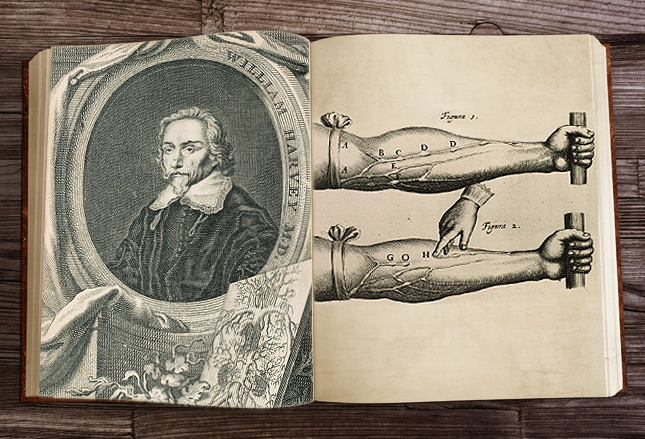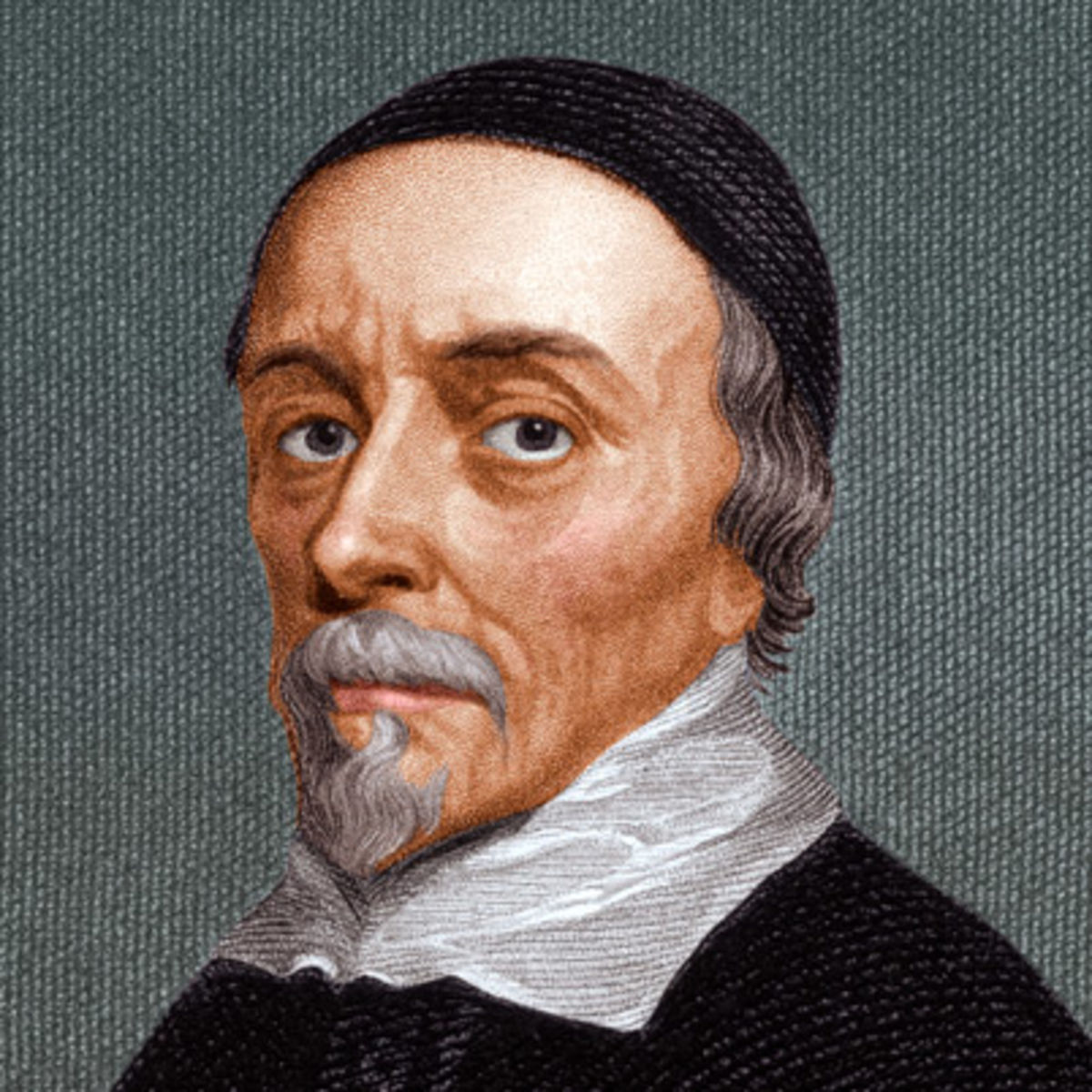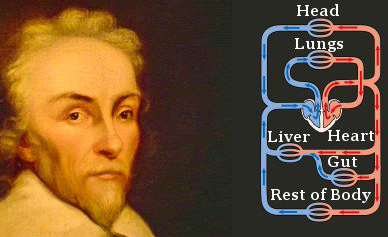William Harvey – Discovery of Circulation
We’ve only just begun, it seems, on our listing of the “50 most influential doctors in history,” a list made some time ago by a medical blog for physicians.
Today we chronicle the man who discerned the true nature of circulation, our number 46 on the list, William Harvey a contemporary of Galileo and Shakespeare and physician to King George of Great Britian.
Sir William Harvey, physician to two English Kings, discoverer of circulation’s true nature
At the time of Harvey’s birth in Kent England on April 1st, 1578 what most of us would call “the era of modern medicine” had NOT yet begun. Frankly, wasn’t even close.
At the time of his death, June 3rd, 1657, it had moved a bit closer… but only a tiny bit.
William Harvey (1578-1657) – #46
Aristocrat, Anatomist, Physician to The King
William was the oldest of the ten children born to Thomas and Joan (Halke) Harvey. His dad was described as a “farmer and landowner” but also as a “jurat of Folkstone” and “a successful businessman who became the mayor of Folkstone.”
Whatever the case, it’s clear that the future doctor William had a privileged childhood and life in the England of the 15-1600’s. His adult propensity toward dissection (of everything) had to have begun with boyhood behaviors, including vivisection, which were not “parented” out of him, as is felt proper in today’s world.
Early Life and Education of William Harvey
William began school in Folkstone, England but at 10 entered the elite King’s Grammar School in Canterbury – effectively leaving home to live with his uncle (remember there were 10 children). There he studied the classics and Latin, essential for academic and legal work.
In 1593 William entered what we would today call “college” at Gonville and Caius College, Cambridge ostensibly studying “arts and medicine” for 6 years before progressing to the University of Padua in Italy to study “medicine” under the tutelage of anatomist and surgeon Hieronymous Fabricius who, in 1574, had discovered the one-way valves in veins – even though he didn’t publish it until 1603. (Padua is also where Galileo was currently living and teaching)

After graduating in 1602, he returned to England to work as a doctor; then, he married Elizabeth, the daughter of Launcelot Browne in 1604. Launcelot was the physician to King James I, so William’s entrenchment into the aristocracy was furthered. The couple were very fond of each other but remained childless.
Later life: Kings and Witches
Like most English physicians of note, William joined the Royal College of Physicians of London and was accepted as a fellow in 1607. Eight years later he was appointed the society’s Lumleian Lecturer in Surgery which he held until 1656.
When he was 31 he was appointed physician at St. Bartholomew’s Hospital and held it for 34 years until political overthrow had him replaced due to his staunch loyalty to the king.
Speaking of kings, he was appointed physician to King James I in 1618 (age 40) and led the doctor group attending him during his last illness when the duke of Buckingham was accused of poisoning him. William was an important witness at duke George Villiers trial and was rewarded by the new King Charles I in 1632 (age 54) for how he cared for his father.
This was also the time of “witches” and the European witch hunts. William had to examine four women accused of witchcraft at a time when belief in witches was nearly universal and to deny their existence was heresy-worthy and punishable. To his credit he considered scientific principles and the women were found innocent.
Both of his royal patients facilitated his obsession to cut things open and study them by donating animals from their herds of deer. That habit continued in earnest when William was sent on a diplomatic mission to see the Holy Roman Emperor, Ferdinand II, involving a year of travel around Europe. He dissected animals and human bodies all over Europe and kept meticulous records.
In his travels he met many influential men in medicine and demonstrated the circulation of blood to them. They must have been impressed because we have record that they wrote about him in their journals.
Medicine In Harvey’s Time
At Harvey’s time Galen (we’ll talk about him later) and his blood-letting principles were all the rage. Despite having to flee his country for challenging the “quacks” of his time and ultimately changing medicine entirely, Galen still had no clue about the inner working of the body and fell victim to the absurd logic of the time:
THEN “Current” Beliefs of “Medicine”
- Blood passed between chambers of heart through “invisible pores.”
- Arteries and veins not connected except through the “pores” in the heart.
- The heart produced the body’s heat and the lungs “fanned and cooled” it like bellows.
- The heart sucked in air during dilation and expelled “vapours” during contraction through pores in the flesh.
- Two separate systems of fluids: “Nutritive” (purple), created by liver sent to body; “Vivyfying” (scarlet), distributes a “life-giving principle” from lungs.
- (possibly) Blood passes through heart to lungs to “become red” and let the lungs “get rid of sooty fumes.”
- Blood consumed by the body at the same rate it was produced by the liver (i.e. didn’t circulate)
- Arab and other scholars had been executed for proposing “circulation” between lungs and heart.
Today we understand their beliefs still leave a lot, if not most, of the truth about circulation completely unknown. Harvey helped, a bit, but still just didn’t get it. Nobody did until things like microscopes, capillaries and the true role of oxygen on the blood were discovered much later.
Harvey’s “Discovery” of Circulation

You didn’t get to be a person like Harvey in those times without learning to tap-dance through “political correctness” and knowing when to keep your mouth shut! Harvey seemed to be a master at it; but, still drew his share of fire from the “quacks” who were making lots of money from blood-letting.
His technique was to demonstrate principles he’d discovered (or what previously executed scientists had paid the price for proposing) in such a way that people would make obvious conclusions on their own. Sort of like how he got out of his dilemma with the witches.
He’d clamp off circulation in a persons arm with a tourniquet and demonstrate filling and direction of flow. He’d show skeptical, influential men actual dissections and ask what they saw and their interpretations. He showed blood “flowing” when the heart contracted not “sucking.” He showed valves in neck veins faced the “wrong way” to act against gravity and instead acted against the heart’s contraction.
He measured blood from bodies (there was, after all, the guillotine) and used (deliberately very conservative) estimates for how much each heart beat would “use up” in order to calculate how much blood the liver must need to “produce” in a day if that was what it was doing. (Basic stuff elementary school children do today.)
Looking at the numbers he’d ask people the logic and stand back and ask what their interpretation might be. The heart was pumping vastly more blood than the liver possibly could be producing in a day. The body’s blood just had to be circulating and being reused in a cycle.
Finally in 1628, after enough time and influential people had been shown and hopefully “convinced,” he published the Anatomical Exercise on the Motion of the Heart and Blood in Animals (translated title from Latin) then translated into English in 1653. A good experience for the world, but not for him – the quacks came out in force… again! They made his life miserable.
Later Life and Death

He suffered from gout, kidney stones and insomnia. The firestorm of controversy after his book diminished his medical practice and his resulting depression prompted a failed attempt to commit suicide using laudanum, an alcoholic tincture of opium.
England went through parliamentary reform and troops ransacked his Whitehall house (1642) destroying much of his research records on patients, autopsies and animal dissections; including an entire unpublished book and materials about “the generation of insects.” He considered this “my greatest crucifying” but was to again loose further material in the Great London Fire of 1666.
He died on June 3, 1657, at the age of 79, in the home of one of his brothers. Most likely of a cerebral hemorrhage (stroke). His wife Elizabeth had already died and the couple had no children.
We’re not sure how many of his new discoveries he ever got to see people accept during his life. A lot was laid out for them but even 200 years later Galen’s blood letting technique was still being used to shorten the lives of unfortunate patients both in Europe and the new United States of America.
The most notable quote of his which has survived revealed his feelings of futility about his life’s work in a letter to his brother.
“
You know very well the storm my previous research caused. It is often better to grow wise in private at home, than to publish what you have amassed with infinite labor, to stir up storms that may rob you of peace and quiet for the rest of your days.
Biographic Summary
William Harvey was an aristocrat and anatomist who discovered the circulation of the human body.
Born: April 1, 1578, Folkestone, Kent, Eng., oldest of 10 children
Died: June 3, 1657, London
Education: Gonville and Caius College, Cambridge; University of Padua in Italy
Known for: First to recognize the full circulation of the blood in the human body and to provide experiments and arguments to support this idea
Books: Anatomical Exercise on the Motion of the Heart and Blood in Animals
Parents: Thomas and Joan (Halke) Harvey
26 Posts in Top 50 Doctors (top50) Series
- 26 - Carlos Chagas, Chaga's Disease & pneumocystis pneumonia. – 10 Apr 2025
- 27 - Charles D. Kelman - Cataracts – 9 Mar 2023
- 28 - Cicely D. Williams, Kwashiorkor, Breastfeeding, Whistleblower – 21 Jun 2022
- 29 - Dame Cicely Saunders, Hospice – 23 Apr 2018
- 30 - David L. Sackett, Evidence-based Medicine – 2 Apr 2018
- 31 - E. Donnall Thomas & Joseph Murray, Bone Marrow Transplants – 23 Feb 2018
- 32 - Elizabeth Blackwell, women in medicine – 29 Jan 2018
- 33 - Elisabeth Kübler-Ross, stages of grief – 5 Jan 2018
- 34 - Watson & Crick, DNA – 2 Dec 2017
- 35 - Mahmut Gazi Yaşargil, Micro-Surgery – 24 Oct 2017
- 36 - George Papanicolaou, Cytopathology, Cancer – 29 Sep 2017
- 37 - Dr. James Parkinson, Parkinson's Disease – 1 Sep 2017
- 38 - Dr. John Snow, cholera – 20 Aug 2017
- 39 - Dr. Joseph Kirsner, GI Joe – 27 Jul 2017
- 40 - Lawrence (Larry) Einhorn, chemotherapy – 16 Jun 2017
- 41 - Robert Koch, modern bacteriology – 21 Mar 2017
- 42 - Stanley Dudrick, TPN – 28 Feb 2017
- 43 - Stanley Prusiner, neurodegenerative diseases – 25 Jan 2017
- 44 - Victor McKusick, medical genetics – 3 Jan 2017
- 45 - Virginia Apgar, anesthesiology & newborn care – 12 Nov 2016
- 46 - William Harvey, circulation – 12 Oct 2016
- 47 - Zora Janžekovič, burns – 26 Sep 2016
- 48 - Helen Taussig, blue babies – 3 Sep 2016
- 49 - Henry Gray, anatomy – 3 Jul 2016
- 50 - Nikolay Pirogov, field surgery – 11 Jun 2016
- Top 50 Doctors: Intro/Index – 10 Jun 2016
Advertisement by Google
(sorry, only few pages have ads)

